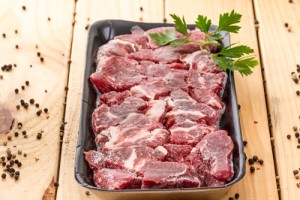Searing A Perfect Steak
 When you’re learning to cook, it’s important to find a few go-to dishes you can prepare with a minimum of time and fuss. Pan-searing steak is one quick, easy way to make a delicious and hearty meal from minimal ingredients. With the following tips, you’ll be well on your way to making a fantastic steak for dinner tonight.
When you’re learning to cook, it’s important to find a few go-to dishes you can prepare with a minimum of time and fuss. Pan-searing steak is one quick, easy way to make a delicious and hearty meal from minimal ingredients. With the following tips, you’ll be well on your way to making a fantastic steak for dinner tonight.
Consider the cut of meat
The first step in preparing an excellent steak is picking the right meat. You want a tender cut of beef with a fat content that fits your personal tastes. High-quality steaks may cost more at the market, but you will see and taste the difference.
Serious Eats recommended choosing from four different varieties of steak for pan searing. Strip steak is tender and has the marbling, or fat within the meat, that many beef-lovers prefer. Select rich, fatty rib eye if you want a particularly juicy and flavorful cut. Filet mignon is exceptionally tender and includes very little fat. The T-bone, a section of rib including both tenderloin and strip, is a big piece of meat that’s also relatively low in fat content. If the T-bone has a tenderloin at least 1.5 inches wide, it is called a porterhouse.
Thickness is another important consideration when you’re at the butcher’s counter. Thicker steaks can take longer to cook, but If the meat is too thin, it will not develop a satisfying crust on the exterior when it is seared. Look for a cut that is between 1.5 and 2 inches thick.

Use a cast-iron skillet
When searing a steak, you don’t want to use just any frying pan. A heavy cast-iron skillet will help to achieve a delicious and perfectly crusted final product. As the Awl explained, cast iron manages high temperatures better than other pans, retaining and evenly distributing the heat more effectively.
If you’re new to using cast iron, keep in mind that the pan is a not a non-stick surface right away when you purchase it. Before cooking your first steak, you must first properly season the skillet. Real Simple advised doing so by adding a coating of cooking oil and placing the pan in an oven set at 350 degrees Fahrenheit for one hour. Dry the skillet with a paper towel and it is ready to cook. However, you may still need to add some oil or butter to prevent sticking for the first few uses.
Cast iron is renowned for its versatility, which can come in handy when cooking a steak. Many chefs , such as Alton Brown, first sear the meat on the stovetop and then place it in an oven set to high heat for two to three minutes. For a Porterhouse, Bon Appetit suggested topping the steak with butter and broiling it for four to six minutes.
Add flavor
You don’t need to soak a steak in a marinade overnight to achieve a great taste. Kosher salt, pepper and, if you like, a light coating of butter or oil will complement the meat’s natural flavors. Sprinkle some salt on the meat before placing it in the skillet. If you are planning to use your broiler to finish the cooking, however, The Kitchn recommended holding off on the pepper until the end of the process to avoid burning off the seasoning.
Don’t overcook
Timing is everything when it comes to searing a steak. Take into account the steak’s fat content and thickness and keep a close eye on it. Using a thermometer will make a tremendous difference in ensuring the meat is cooked properly . According to the Food Network, a steak is considered medium rare when it reaches an internal temperature between 130 and 135 degrees Fahrenheit. For medium doneness, aim for 135 to 140 degrees Fahrenheit. While some may prefer a more well-done steak, be aware that higher internal temperatures mean diminishing its juiciness and flavor.
Let it rest
Whenever preparing meat, you should hold off at least five minutes before serving. Giving the steak time to rest and finish cooking will result in the greatest juiciness in every bite. To prevent the meat’s temperature from dropping too quickly, wrap it in foil. After the steak’s had a little time, it’s ready to be plated and savored.






I have never attempted to cook a steak, but I would love to surprise my husband with one someday. Great information and tips, I do have a cast iron skillet – I may have to give this a try. Thanks for sharing!
Hi sir ..when i coocked stick .guest will complain evry time.can u give me good salution for any sticks .still i dont knowe rare midum rare or midium well .
Hi @Akbar,
A lot of factors go into cooking perfect steaks, like the method in which you cook them (skillet or grill), the temperature the steak is when you cook it (should be room temperature and not cold), the thickness and the cut.
Medium rare means the steak is still slightly pink on the inside. Medium well means the steak is not pink at all and more well done.
You can use this video as a guide: http://learntocook.com/steak/how-to-cook-pan-fried-steak/
I have yet to venture into the world of cooking steak quite yet due to the fact that I am afraid of messing the whole thing up by not cooking it properly. It’s comforting to know that you don’t necessarily need to marinate the steak overnight to get the seasoned taste. The seasoning part is the most overwhelming part of cooking for me, and it’s no different with steak.